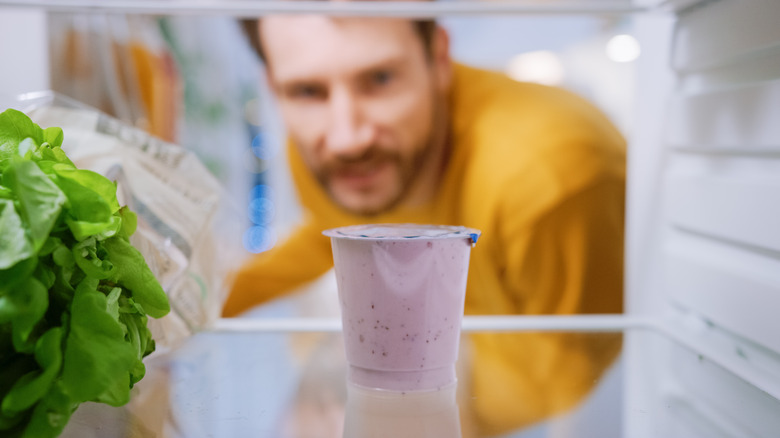How Long An Open Tub Of Yogurt Will Last In The Fridge
Yogurt is a wonderful ingredient to have on hand for both eating and cooking. It's not unusual for people to invest in larger containers of this tart dairy product so it can stretch between multiple meals or snacks. However, as much as we insist we'll use the entire tub and not let any go to waste, we sometimes inevitably let it sit until we're at the point where we have no idea if it's still good. Often, if there's no mold present and it smells okay, we assume it's just fine. But you may want to rethink that less-than-scientific assumption. Contrary to common belief, the sell-by/best-by/use-by dates are often for the grocery store's consideration, not the consumer's.
According to the USDA, you should use a refrigerated container of yogurt within one to two weeks after purchasing it if you want it at its peak of freshness and quality. With that said, common sense is still a factor to consider. If your five-day-old yogurt has developed mold, it should definitely not be consumed. If your yogurt container is swollen or bloated before you've opened it, and you are not in a high-altitude location, this could be a sign of fermentation, and you should probably return it to the store as a precaution. However, if all smells, looks, and tastes well — and it's been less than 14 days since you bought it — your yogurt should be just fine.
How to make yogurt last longer
The freshness date range of seven to 14 days for yogurt is quite broad, but there are steps you can take to ensure your yogurt lasts closer to two weeks than one. For starters, keep your yogurt towards the back of the refrigerator, which stays the coldest. The front, and especially the door of the fridge, is exposed to fluctuating temperatures as the appliance gets opened and closed. Also, make sure your refrigerator is set to 40 degrees Fahrenheit or colder. Keep the lid on tight, or better yet, store the yogurt in an airtight container, which will help keep air and other refrigerator smells out.
Be sure to use clean utensils when you scoop yogurt from the container. In other words, don't eat a bite of yogurt and then use the same spoon to scoop out more. Doing so introduces bacteria into the food, which will speed up spoilage. Finally, if you've taken your yogurt out of the refrigerator to use in a dish, be sure to put it right back in once you're done with it. Keeping it out at room temperature for extended periods only encourages bacterial growth, especially if your kitchen is warm.
How to use up your extra yogurt
If you absolutely hate to waste or throw away food and are determined to use every bit of your supersized container of yogurt, you can use it for more than you may realize. Aside from eating it, yogurt is a fantastic baking ingredient. It adds moisture and flavor, and even acts as a leavener when combined with baking soda. Use plain, full-fat yogurt to make all kinds of muffins, cakes, biscuits, breads, and scones.
Yogurt can be used to thicken and emulsify salad dressings, is a great substitute for sour cream in dips, and lightens up chicken, tuna, or egg salad when used in place of mayonnaise. Thick, Greek yogurt makes incredible gluten-free turkey meatballs as well. You can even freeze yogurt for longer-term storage. When thawed, you might notice a bit of a grainy texture, but it should be perfectly fine for making things like smoothies and frozen yogurt popsicles.
Of course, if you just like to eat yogurt, there is no shortage of ways to flavor it up. Experiment with different fruits (fresh, dried, or freeze-dried), crunchy or candied nuts, citrus zest, jams, compotes, or make it savory with ingredients like fresh dill, extra virgin olive oil, and homemade chili crisp, which would be scrumptious served with poached eggs and toast.



